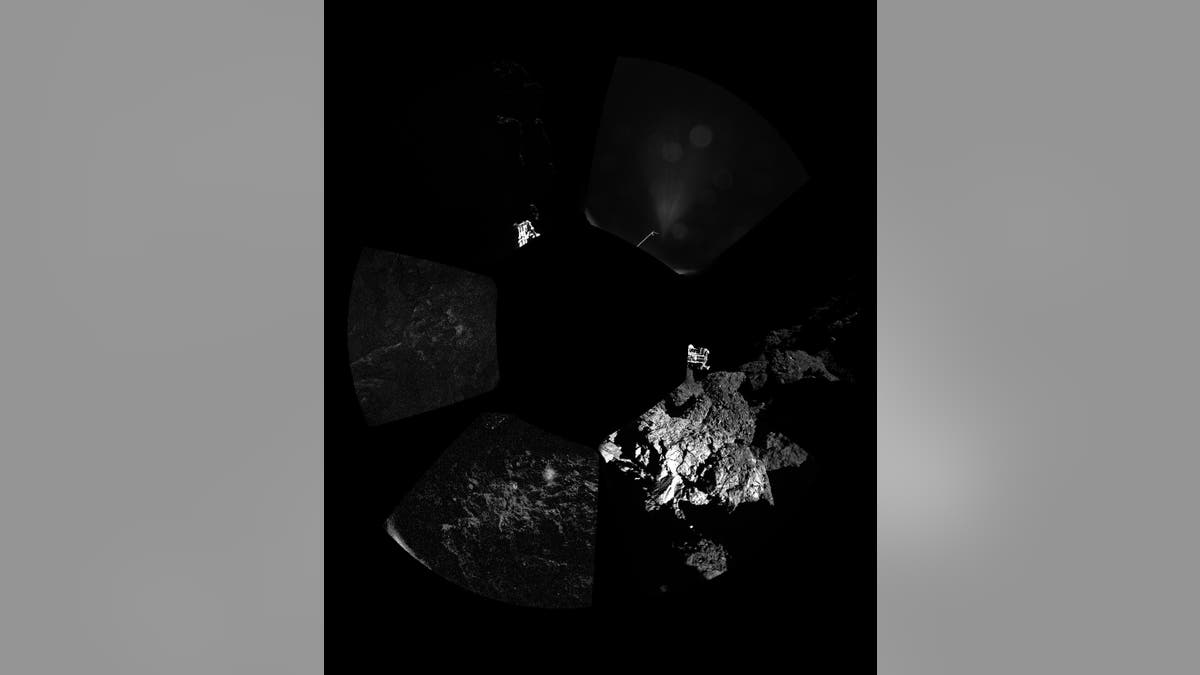
A panoramic image of the comet's surface taken by the Philae lander. (ESA/Rosetta/Philae/CIVA)
The European Space Agency’s Rosetta spacecraft has regained contact with its history-making Philae comet lander, although scientists now face a race against time to extract as much data as possible from the probe before its battery runs out on Saturday.
Scientists had endured an agonizing wait Friday before the Rosetta orbiter re-established contact with the probe. After finally touching down in the wrong location on Wednesday, there were fears that the lander would run out of battery power before the connection could be made.
“Philae still talking!” declared the agency, in a blog post late on Friday, confirming that Rosetta’s “communication pass” began at 5:29 p.m. ET.
The Philae lander made history on Wednesday when it became the first probe to land on a comet. 67P/Churyumov-Gerasimenko, which is about 2.5 miles wide and travels at speeds up to 84,000 miles per hour, is 317 million miles from earth.
The challenge for scientists now is to grab as much information as possible from the probe before its power is exhausted. The probe’s exact location on the comet also remains unknown, according to the ESA.
“While the search for the final landing site is still on-going, the lander is racing against the clock to meet as many of the core science goals as possible before the primary battery is exhausted,” explained the ESA, in its blog post. “Under the low illumination conditions at Philae’s location, it is unlikely that the secondary batteries will charge up enough to enable extended surface operations.”
With Philae’s solar panels unlikely to generate enough long-term power for the secondary batteries, the probe’s mission is expected to end sometime on Saturday, according to the ESA. “Future contacts are possible if the illumination conditions change as the comet orbits closer to the Sun, enabling solar power to flow again,” it added.
During a press conference early on Friday, ESA scientists said that the probe may receive enough solar power to communicate when its orbit nears the sun in August 2015.
Known as a “short period comet,” 67P/Churyumov-Gerasimenko takes 6.6 years to orbit the sun.
The culmination of an audacious 10-year mission, the Philae lander separated from its Rosetta mothership and successfully descended to the comet Wednesday. The touchdown, however, was fraught with problems, and the lander bounced twice before landing in the shadow of a cliff – a serious problem for the solar panels designed to provide long-term power to Philae after its primary battery is exhausted.
In Friday's press conference, ESA scientists discussed altering Philae’s position by activating its landing gear in an attempt to illuminate its solar panels.
On Friday evening ESA Operations tweeted that Philae’s landing gear “lifted 4cm” (1.6 inches), adding that probe’s “main body rotation” was complete.
Designed to collect a host of data, one of Philae’s key tools is a drill, which will help scientists analyze the comet’s structure.
On Friday the ESA confirmed that the drill has extended around 10 inches from the lander’s base plate, but were unable to tell whether it has penetrated the comet’s substrate.
Early on Thursday, the ESA released the first picture taken by the probe after determining that the craft had stabilized following its tension-filled landing. The agency subsequently released the first panoramic picture taken from the lander. The three feet of Philae's landing gear can be seen in some of the frames.
Philae and the Rosetta spacecraft planned to use 21 instruments to analyze the comet. Scientists hope the $1.62 billion mission will help them better understand comets and other celestial objects, as well as possibly answer questions about the origins of life on Earth
Follow James Rogers on Twitter @jamesjrogers
The Associated Press contributed to this report.




















